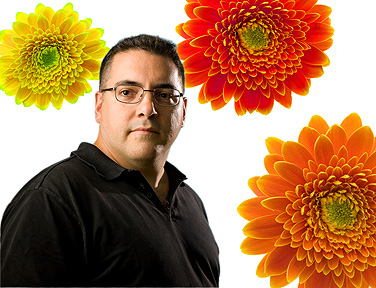Close Up
Understanding new species

Lady slipper orchids, first seen as a child at a flower show, inspired Victor Albert’s research on the evolution of flowering plants. Photo: DOUGLAS LEVERE
The lady slipper orchid is a fascinating thing, a variety of flower that deals in deception, in entrapment. Each of these plants possesses a slipper-shaped pouch that lures insects looking for a meal or a place to lay eggs. Once inside, the tiny creatures find little or no nectar to satisfy their appetite. Instead, they discover that the only way out is to climb past the orchid’s stigma and anthers, pollinating the flower in the process of escaping.
It was these lady slipper orchids, these cunning organisms, that inspired and instilled in Victor Albert a passion for flowers. He first laid eyes on such plants when he was a boy, when his parents took him to a flower show at the U.S. National Arboretum near his Maryland home. At 13, he began growing orchids and wanted to know everything about them—why they came in different colors, why they exhibited different traits. Their complexity captivated him.
Years later, flowers still hold mystery for Albert, who joined the UB faculty last year as an Empire Innovation Professor in biological sciences. The questions that command his attention today are much more complicated than those that fueled his teenage curiosity.
An expert in the evolutionary biology of flowering plants and a scientist in UB’s New York State Center of Excellence in Bioinformatics and Life Sciences, Albert, formerly a faculty member at the University of Oslo in Norway, is conducting research that will lead to a better understanding of what drives the development of new species.
He is collaborating with colleagues at institutions including the University of Arizona, University of Florida and Pennsylvania State University to sequence the genome of Amborella, an understory shrub or small tree found only on the Pacific island of New Caledonia. Because Amborella is thought to be one of the most primitive flowering plants on Earth—a direct descendant of the common ancestor of all flowering plants—sequencing its genome and comparing its genetic information to that of species in newer lineages could provide insight into the characteristics of early flowering plants and how they evolved.
Albert also is studying whole-genome duplication, a process linked to reproduction that produces plants carrying double the number of chromosomes their parents have. One of his areas of inquiry is what happens following genome doubling—why some genes are retained and others are deleted. In organisms resulting from whole-genome duplication, redundant copies of the same genes can evolve to develop new functions, giving plants new characteristics. Albert suggests that the doubling process may be behind what some people call “Darwin’s abominable mystery”—the abrupt appearance of a wide variety of flowering plants in fossil records dating to the Cretaceous period.
“How did they all of a sudden bang, explode? …We have strongly suggested that whole genome duplication has been behind this radiation of flowering plants in general, and we’ve suggested that it’s behind smaller radiations within the flowering plants,” Albert says. “Other people are publishing on this as well. This is becoming a commonly held view these days. We are trying to more accurately test that hypothesis.”
At the Center of Excellence, Albert says he has enjoyed working with colleagues across diverse fields. Scientists there deal with topics ranging from human and yeast genetics to pharmaceuticals, and many share Albert’s interest in genomics and developmental biology. Within the center, however, he says he is the only faculty investigator whose specialty is plants.
On the window sill of his office on the Downtown Campus, Albert keeps three white lady slipper orchids called Mexipedium, a name he gave those flowers in the early 1990s after determining they comprised their own genus. In nature, these orchids have only been observed in one place, Oaxaca, Mexico, where seven of them were growing at the time of their discovery.
As the subject of scientific inquiry, flowers, in all their complexity, always will present new questions for researchers to answer. And as Albert and others continue unraveling mysteries surrounding plants, an argument could be made that the rest of us should be paying attention.
“All crops, one way or another, come from flowers, except for things like lettuce. Rice, corn, it’s all from flowers. …Human health is not just about understanding human genes and genetics, but also understanding the stuff that’s eaten by humans all over the world,” Albert says. “The global carbon dioxide crisis, all this has to do with plants because plants are sucking in carbon dioxide and producing oxygen. Plants are vital to human survival.”

Reader Comments